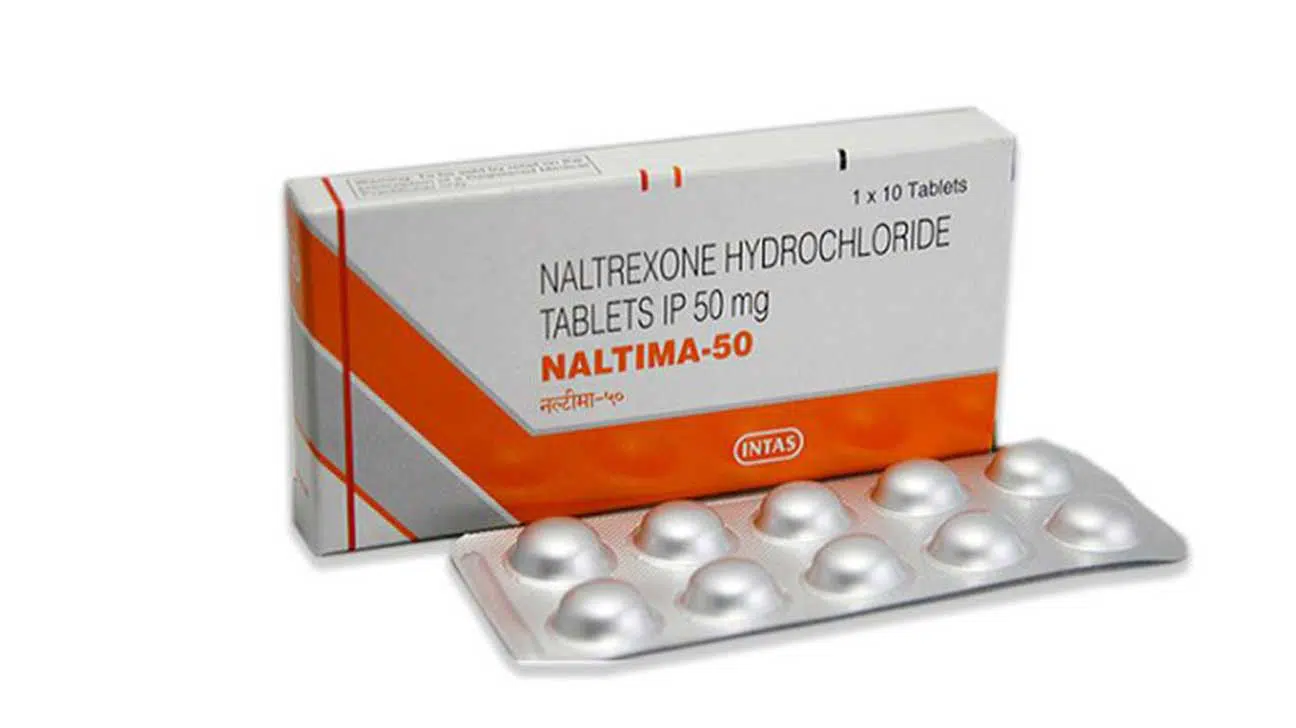
Naltrexone, also known as ReVia and Vivitrol, is a medication that is FDA-approved as a medication-assisted treatment for opioid use disorder and alcohol dependence.
What naltrexone can do:
- block the effects of opioid drugs (including heroin)
- block the effects of alcohol
- reduce cravings for both alcohol and opioids
- prevent a person from getting high
Unlike other medications for opioid use disorder, such as methadone and buprenorphine, naltrexone is not an opioid medication.
Naltrexone is non-addictive, doesn’t lead to physical dependence, and therefore does not result in withdrawal with stopped use.
Learn more about the benefits of medication-assisted treatment
How Naltrexone Works
Naltrexone is a type of drug that’s known as an opioid antagonist. It blocks other opioids from activating receptors in the brain by occupying those receptors itself.
Because of this, it can effectively block the euphoric and sedative effects of opiates and alcohol, which prevents a person from getting high.
Naltrexone should not be taken while a person is still actively drinking or using opioids. Individuals should be fully detoxed from all substances before starting naltrexone.
Read more about how Naltrexone works
When Will Naltrexone Take Effect?
Naltrexone works relatively quickly, within one to two hours of administration depending on the type of formulation taken:
- intramuscular injection (Vivitrol): The effects of Vivitrol, injected once a month, reach an initial peak about two hours after injection.
- tablet form: The oral tablet form of naltrexone takes effect shortly after the first dose, within one to two hours.
- implant: The effects of a naltrexone implant release slowly over a 10- to 12-week period. Note: Naltrexone implants are not currently available in the U.S.
Various factors, including a person’s metabolic rate, substance use, and genetics can affect how long it takes for naltrexone to take effect.
Read more about how long it takes for Naltrexone to kick in
Side Effects Of Naltrexone
Like any drug, naltrexone may cause some side effects. Side effects are generally mild and may go away with time as the body adjusts to the use of naltrexone.
Common side effects of naltrexone include:
- stomach cramps
- difficulty sleeping
- anxiety
- nausea or vomiting
- headache
- low energy
- muscle, bone, or joint pain
- changes in mood
Serious side effects, although rare, can also occur. If you develop severe side effects such as confusion or hallucinations, contact your doctor right away.
Read more about the side effects of Naltrexone
Effects On Weight
Decreased appetite, diarrhea, and nausea are common side effects of naltrexone, which may result in weight loss while taking this medication.
Unlike methadone and buprenorphine, naltrexone is not associated with weight gain.
Read more about weight changes caused by Naltrexone
Dream Changes
Vivid dreams and nightmares can occur while taking naltrexone, due to how naltrexone interacts with dopamine and serotonin, two chemicals in the brain.
Read more about how Naltrexone can cause dream changes
Feelings Of Nausea
Nausea is a common side effect of naltrexone. This may or may not fade with time.
If you continue to feel very nauseous while taking naltrexone, your doctor may be able to offer suggestions for how to help ease nausea while taking this medication.
Read more about nausea caused by Naltrexone
Having Hallucinations
Seeing or hearing things that aren’t there (hallucinations) is a rare, but potential side effect while taking naltrexone.
When it does occur, it generally only lasts for a short time. However, this is considered a serious side effect, and should be reported to a doctor as soon as possible.
Read more about the potential for Naltrexone to cause hallucinations
Sexual Side Effects
Naltrexone, like buprenorphine and methadone, can have effects on sexual function and the menstrual cycle when taken for opioid addiction.
Sexual side effects associated with naltrexone use include:
- erectile dysfunction
- early morning erections
- restoring menstruation
- reduced sexual desire
The likelihood of experiencing sexual side effects from naltrexone may depend on the dose taken, a person’s substance use history, and other factors.
Read more about the sexual side effects of Naltrexone
Developing Mania
Research on the use of naltrexone in people with a substance use disorder and co-occurring bipolar disorder has shown mixed results.
People with bipolar disorder who take naltrexone may see a reduction in manic symptoms, or experience worsened symptoms of mania and depression.
Read more about how Naltrexone can affect mania
Possible Liver Damage
Naltrexone use may cause worsened liver or kidney damage in people who already have impaired hepatic or renal function.
Signs of liver damage can include:
- yellowing of the eyes or skin (jaundice)
- stomach pain lasting for more than a few days
- dark urine
- chronic fatigue
If you have impaired liver function, or are experiencing signs of liver damage while taking naltrexone, contact your prescribing physician right away.
Read more about how taking Naltrexone can negatively impact the liver
Effects Of Combining Naltrexone With Other Drugs
There are several types of substances, including alcohol and other opioids, that should be avoided while taking naltrexone due to the potential for a negative interaction.
Potential effects of combining naltrexone with other drugs:
- reduced drug effectiveness
- intoxication
- accidental opioid overdose
Before starting naltrexone, be sure to tell your doctor about any drugs, including prescription medications, you’re currently taking.
Read more about the effects of combining Naltrexone with other drugs
Naltrexone Dosage
Naltrexone comes in a couple dosage strengths. Dosing for naltrexone is determined based on the formulation, the intended use, and prescribed frequency of use.
Common dosages include:
- Tablet form: 50 mg naltrexone
- Injection: 380 mg naltrexone
- Implant: 200 mg naltrexone (not available in the U.S.)
Average Naltrexone Dose
The average dose of naltrexone differs depending on the form of naltrexone you are taking: naltrexone in pill/tablet form or the naltrexone injection (Vivitrol).
The dose provided for individuals can vary according to personal factors, including duration of opioid/alcohol dependence and overall health.
Read more about the average dose of Naltrexone
How Often Naltrexone Is Taken
Naltrexone for alcohol dependence (tablet form) is taken either once, daily, or three times a week.
The injectable form of naltrexone (Vivitrol) is administered intramuscularly (into the muscle) once a month, typically in an outpatient setting.
Read more about how often you need to take naltrexone
How To Take Naltrexone
Naltrexone is taken in the form of an oral tablet or intramuscular injection.
The tablet form of naltrexone is taken by mouth. This can be taken at home, with or without food. Eating prior to taking naltrexone may help prevent stomach upset.
Naltrexone injections are injected into the muscle by a medication-assisted treatment (MAT) practitioner such as a nurse or doctor.
Read more about how to properly administer Naltrexone
How Long Will You Be On Naltrexone?
Naltrexone can be prescribed as a long-term medication-assisted treatment (MAT) for opioid use disorder or alcohol dependence.
How long naltrexone treatment lasts depends on each person’s individual treatment experience, including progress in treatment and the recommendation of their doctor.
Read more about how long Naltrexone lasts
Getting A Naltrexone Prescription
Naltrexone tablets for alcohol dependence can be prescribed by any healthcare practitioner that is licensed to prescribe medication.
Administering Vivitrol (naltrexone injections) for opioid addiction, however, requires a Risk Evaluation Mitigation Strategy (REMS), which is a type of drug safety program.
Not all prescribing physicians may offer naltrexone injections. However, they may be able to offer a referral to a doctor or treatment center that does.
Read more about who can prescribe Naltrexone
Naltrexone FAQs
Find answers to frequently asked questions about naltrexone for opioid use disorder or alcohol use disorder.
❓ Can Naltrexone Help With Anxiety?
✔️ Anxiety is a common side effect of naltrexone. However, some research suggests it may also be helpful for decreasing anxiety in people with co-occurring anxiety disorders.
Read more about how Naltrexone can affect anxiety
❓ What Happens If You Take Naltrexone With Opioids?
✔️ Naltrexone should not be taken until a person has fully detoxed. Taking naltrexone with opioids still in your system could cause precipitated withdrawal.
Taking very high doses of an opioid drug can also lead to accidental overdose, due to an inability to gauge the effects of opioids in the body and decreased opioid tolerance.
Read more about the effects of taking Naltrexone with opioids
❓ Can You Get Drunk While Taking Naltrexone?
✔️ Drinking alcohol while taking naltrexone is not recommended. Naltrexone blocks the euphoric effects of alcohol (“the buzz”) but it doesn’t prevent impairment.
Read more about drinking alcohol while on Naltrexone
❓ How Much Does Naltrexone Cost?
✔️ The cost of naltrexone can vary depending on a wide range of factors.
This includes:
- drug formulation (i.e. tablet vs. injection)
- dosage
- brand name or generic version
- type of health insurance
- state of residence
The average cost of oral naltrexone is $25 to $60 a month.
Naltrexone provided by an opioid treatment program may cost up to $1,1756 for a monthly injection and related support services.
Read more about the cost of Naltrexone
Find Naltrexone Treatment For Addiction Today
Naltrexone is one of several medications that are FDA-approved for the treatment of opioid use disorder and alcohol addiction.
If you’re looking for naltrexone treatment for yourself or a loved one struggling with addiction, we may be able to help.
Call our helpline today to speak to one of our trained staff members about finding naltrexone treatment options near you.
Addiction Resource aims to provide only the most current, accurate information in regards to addiction and addiction treatment, which means we only reference the most credible sources available.
These include peer-reviewed journals, government entities and academic institutions, and leaders in addiction healthcare and advocacy. Learn more about how we safeguard our content by viewing our editorial policy.
- Depression and Anxiety — Brief Report: Naltrexone in Patients With Bipolar Disorder and Alcohol Dependence
http://www.naltrexone.com/10.1002@da.20213.pdf - Science Direct — Sexual Dysfunction among Male Patients Receiving Buprenorphine and Naltrexone Therapy for Opioid Dependence
https://www.sciencedirect.com/science/article/abs/pii/S1743609515338431 - Substance Abuse and Mental Health Services Administration (SAMHSA) — Naltrexone
https://www.samhsa.gov/medication-assisted-treatment/medications-counseling-related-conditions/naltrexone - U.S. Food and Drug Administration (FDA) — REVIA Label
https://www.accessdata.fda.gov/drugsatfda_docs/label/2013/018932s017lbl.pdf - U.S. National Institute on Drug Abuse (NIDA) — How much does opioid treatment cost?
https://www.drugabuse.gov/publications/research-reports/medications-to-treat-opioid-addiction/how-much-does-opioid-treatment-cost - U.S. National Institute on Drug Abuse (NIDA) — Opioid Addiction
https://www.drugabuse.gov/publications/principles-drug-addiction-treatment-research-based-guide-third-edition/evidence-based-approaches-to-drug-addiction-treatment/pharmacotherapies/opioid - U.S. National Library of Medicine: PubMed — Treatment of idiopathic erectile dysfunction in men with the opiate antagonist naltrexone -- a double-blind study
https://pubmed.ncbi.nlm.nih.gov/8294223/


